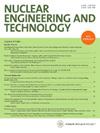评估核燃料性能模拟中 DIONISIO-SubChanFlow 代码耦合的影响
IF 2.6
3区 工程技术
Q1 NUCLEAR SCIENCE & TECHNOLOGY
引用次数: 0
摘要
核燃料性能的真实模拟不仅需要能够描述辐照条件下燃料内部发生的热机械现象的有效模型,还需要对提供系统边界条件的燃料棒周围通道的热水力学进行详细描述。在这项工作中,介绍了将热水力学代码 SubChanFlow 与燃料性能代码 DIONISIO 相结合的主要结果和前景。为实现这一目标,我们实施了内部耦合,将 DIONISIO 用作主代码,控制 SubChanFlow 作为热工水力学子程序,取代 DIONISIO 中已嵌入的简化版本。作为第一种方法,我们进行了多次测试,以确保耦合器在正常运行条件下的性能和质量。此外,据观察,与实验数据相比,该耦合在描述包层温度和相关变量(如氧化物厚度和氢吸收)方面有显著改进。本文章由计算机程序翻译,如有差异,请以英文原文为准。
Assessing the impact of DIONISIO-SubChanFlow code coupling in nuclear fuel performance simulations
Realistic simulation of nuclear fuel performance requires not only validated models capable of describing the thermomechanical phenomena that take place within the fuel under irradiation conditions, but a detailed description of the thermal hydraulics of the channel surrounding the fuel rods, which provides the boundary conditions of the system. In this work, the main results and outlooks of coupling the thermal hydraulics code SubChanFlow with the fuel performance code DIONISIO are presented. To achieve this, an internal coupling was implemented, wherein DIONISIO is used as a master code controlling SubChanFlow as a thermal hydraulics subroutine replacing the simplified version already embedded in DIONISIO. Several tests were conducted to ensure the performance and quality of the coupling under normal operation conditions as a first approach. In addition, it was observed that the coupling demonstrated a significant improvement in the description of the cladding temperature and related variables, such as oxide thickness and hydrogen uptake, when compared with experimental data.
求助全文
通过发布文献求助,成功后即可免费获取论文全文。
去求助
来源期刊

Nuclear Engineering and Technology
工程技术-核科学技术
CiteScore
4.80
自引率
7.40%
发文量
431
审稿时长
3.5 months
期刊介绍:
Nuclear Engineering and Technology (NET), an international journal of the Korean Nuclear Society (KNS), publishes peer-reviewed papers on original research, ideas and developments in all areas of the field of nuclear science and technology. NET bimonthly publishes original articles, reviews, and technical notes. The journal is listed in the Science Citation Index Expanded (SCIE) of Thomson Reuters.
NET covers all fields for peaceful utilization of nuclear energy and radiation as follows:
1) Reactor Physics
2) Thermal Hydraulics
3) Nuclear Safety
4) Nuclear I&C
5) Nuclear Physics, Fusion, and Laser Technology
6) Nuclear Fuel Cycle and Radioactive Waste Management
7) Nuclear Fuel and Reactor Materials
8) Radiation Application
9) Radiation Protection
10) Nuclear Structural Analysis and Plant Management & Maintenance
11) Nuclear Policy, Economics, and Human Resource Development
 求助内容:
求助内容: 应助结果提醒方式:
应助结果提醒方式:


